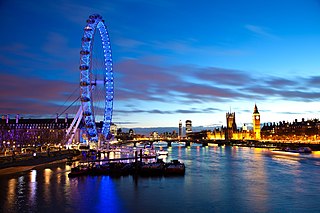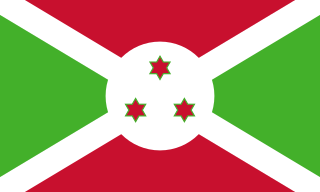
Tourism in Burundi refers to tourism in Burundi. Bujumbura, the largest city and former capital of Burundi, is a major tourist attraction of the country. [1] In addition to this, Lake Tanganyika is a popular tourist attraction. [2]

Tourism in Burundi refers to tourism in Burundi. Bujumbura, the largest city and former capital of Burundi, is a major tourist attraction of the country. [1] In addition to this, Lake Tanganyika is a popular tourist attraction. [2]
Burundi has vast natural resources and wildlife, but the tourism industry of Burundi is underdeveloped. Tourism has a marginal share in GDP of the nation. [3] Direct contributions of travel and tourism industry to the country's GDP was 2.1% in 2013 and 2% in 2014. [4] According to World Bank data, the number of international tourists increased in the 2000s. In 2000, nearly 29,000 international tourists visited Burundi, the number increased to 148,000 in 2005. Number of tourists peaked at 214,000 in 2006; by 2010, only 142,000 tourists had visited the country. [5] [6] While the tourism sector is small but growing, ongoing unrest has decimated tourism in the country. [7] [8]
Tourism infrastructure is very poor in Burundi. The options for transport and accommodation for tourists are limited. In 2010, the Burundian government planned a 20-year infrastructure development plan in partnership with the African Development Bank to improve tourism infrastructure in the country. The funding also came from other donor nations and organizations. [3]
Yellow fever vaccination is necessary before visiting Burundi. Malaria is endemic in Burundi, while vaccination for cholera may also be required when visiting Burundi. [9] [10]
Ecotourism is one of the major areas of tourism in Burundi. Kibira National Park, Rurubu River and Lake Tanganyika are considered major natural habitats for wildlife. There are also numerous wildfowl lakes, such as Rwihinda Lake Natural Reserve. [3]
Burundian drummers, locally known as Abatimbo, are one of the major cultural attractions. Wooden drums are part of ancient Burundi culture. Their sound is known as "ancient" and "sacred" sound in Burundi and also a symbol of unity. In 2014, the ritual Burundian drum dance was placed on UNESCO's Intangible Cultural Heritage list. [11] In 2017, President Pierre Nkurunziza limited drumming rituals to official events and banned women from drumming. [12]
There is no UNESCO-recognized World Heritage Site in Burundi but there are 10 sites which are on UNESCO's tentative list. These 10 sites includes Gishora, Mugamba, Muramvya, Gasumo (the southernmost source of the Nile), Lake Rwihinda Natural Reserve, Lake Tanganyika, Rusizi National Park, Kibira National Park, Ruvubu National Park and the Kagera waterfalls. [13]
There are a number of systems of transport in Burundi, including road and water-based infrastructure, the latter of which makes use of Lake Tanganyika. Furthermore, there are also some airports in Burundi.

Bujumbura, formerly Usumbura, is the economic capital, largest city and main port of Burundi. It ships most of the country's chief export, coffee, as well as cotton and tin ore. Bujumbura was formerly the country's political capital. In late December 2018, Burundian president Pierre Nkurunziza announced that he would follow through on a 2007 promise to return Gitega its former political capital status, with Bujumbura remaining as economical capital and center of commerce. A vote in the Parliament of Burundi made the change official on 16 January 2019, with all branches of government expected to move to Gitega within three years.

A tourist attraction is a place of interest that tourists visit, typically for its inherent or an exhibited natural or cultural value, historical significance, natural or built beauty, offering leisure and amusement.

Tourism plays a significant part in the economic life of England. In 2018, the United Kingdom as a whole was the world's 10th most visited country for tourists, and 17 of the United Kingdom's 25 UNESCO World Heritage Sites fall within England.
Tourism in India is 4.6% of the country's gross domestic product (GDP). Unlike other sectors, tourism is not a priority sector for the Government of India. The World Travel and Tourism Council calculated that tourism generated ₹13.2 lakh crore (US$150 billion) or 5.8% of India's GDP and supported 32.1 million jobs in 2021. Even though, these numbers were lower than the pre-pandemic figures; the country's economy witnessed a significant growth in 2021 after the massive downturn during 2020. The sector is predicted to grow at an annual rate of 7.8% to ₹33.8 lakh crore (US$400 billion) by 2031. India has established itself as the 5th largest global travel healthcare destination with an estimated market size of around $9 billion in 2019, out of the total global travel healthcare industry of $44.8 billion(2019). In 2014, 184,298 foreign patients travelled to India to seek medical treatment.

Gitega, formerly Kitega, is the political capital of Burundi. Located in the centre of the country, in the Burundian central plateau roughly 62 kilometres (39 mi) east of Bujumbura, the largest city and former political capital, Gitega is the country's fourth largest city and former royal capital of the Kingdom of Burundi until its abolition in 1966. In late December 2018, Burundian president Pierre Nkurunziza announced that he would follow on a 2007 promise to return Gitega its former political capital status, with Bujumbura remaining as economic capital and centre of commerce. A vote in the Parliament of Burundi made the change official on 16 January 2019, with all branches of government expected to move in over three years.

Jean-Baptiste Bagaza was a Burundian army officer and politician who ruled Burundi as president and de facto military dictator from November 1976 to September 1987.

Melchior Ndadaye International Airport is an airport in Bujumbura, the former capital of Burundi. It is Burundi's only international airport and the only one with a paved runway.
Montenegro is one of the fastest-growing tourist destinations. In 2007, over a million tourists visited Montenegro, making some 7.3 million overnight stays. This accounted for some 480 million euros in tourism revenue in 2007. In 2015, tourism realised over 1.7 million arrivals, with a further increase in 2016. In the same year, the coastal town of Kotor was named the best city to visit by Lonely Planet, whereas the country itself is continuously included in touristic top lists. With a total of 1.8 million visitors in 2016, the nation became the 36th most popular country to travel to in Europe. Montenegro was further visited by over 2 million tourists in 2017. The Government aims to attract greenfield investments, which should make best use of undeveloped parts of the coast, such as Jaz Beach, Velika Plaža, Ada Bojana and Buljarica.

The wildlife of Burundi is composed of its flora and fauna. The small, landlocked country is home to 2,950 species of plants, 596 birds, 163 species of mammals, 52 species of reptiles, 56 species of amphibians, and 215 fish species. The wildlife has been drastically reduced in recent years, mainly on account of intense population pressure, conversion of large areas of forest into agricultural land, and extensive livestock farming. The protected area encompasses little more than 5% of the total area of the country.

The following outline is provided as an overview of and topical guide to Burundi:

Tanzania is a country with many tourist attractions. Approximately 38 percent of Tanzania's land area is set aside in protected areas for conservation. There are 17 national parks, 29 game reserves, 40 controlled conservation areas and marine parks. Tanzania is also home to Mount Kilimanjaro, the highest point in Africa.
Malawi, officially known as the Republic of Malawi, is a country located in southeastern Africa. The country is also referred to as "The Warm Heart of Africa", due to the friendliness of the people.

Burundi, officially the Republic of Burundi, is a landlocked country in the Great Rift Valley at the junction between the African Great Lakes region and Southeast Africa, with population of over 14 million people. It is bordered by Rwanda to the north, Tanzania to the east and southeast, and the Democratic Republic of the Congo to the west; Lake Tanganyika lies along its southwestern border. The capital city is Gitega and the largest city is Bujumbura.
Prostitution in Burundi is illegal but is commonplace and on the rise. Prostitution is prevalent in all areas of the country, and especially in the largest city, Bujumbura, and prior to the security crisis in 2015, the tourist areas around Lake Tanganyika. UNAIDS estimate there are 51,000 prostitutes in Burundi. Many women have turned to prostitution due to poverty. Previously law enforcement made little effort to curb prostitution. Political pressures, including from the mayor of Bujumbura, Freddy Mbonimpa, have led to crackdowns all over the country.

The Ritual dance of the royal drum is a drumming tradition from Burundi that combines synchronised drumming with dancing and traditional songs. In 2014, it was added to the Representative List of the Intangible Cultural Heritage of Humanity by UNESCO.

Lake Rwihinda, also known as the Lac aux Oiseaux is a lake in the Kirundo Province of Burundi. It is home to diverse migratory birds, which are the main tourist attraction in the region. However, despite being protected, it is under threat from encroaching agriculture in this very poor region.
The Mpanda River is a river in Bubanza Province, Burundi. It is a tributary of the Ruzizi River.
The Mutimbuzi River is a river in Bujumbura Rural Province, Burundi.